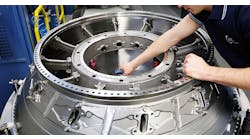... The roller is not used. The billet is put directly into the blocker. The billet material is 8630, 2.25 in. in diameter. The die block is made of FX T1 and measures 14314 in. The dies are not pre-heated. Any information would be appreciated.
A: There are several basic rules that you may not be following:
1. Finishing blow. Is it gaining thickness, or is it “one more for good measure”? You advised that this was not the general practice.
2. Die-wall thickness. You advised that the ratio was closer to 2:1 than to 2.5: 1 (the general practice.) I favor a 3:1 ratio for tough parts. For this reason, I believe the die size is small for the job, as well as for the impact area, which seems rather small for the hammer size.
3. Die preheating. Is this die preheated to at least 300ºF during the first forging blow? If not, these die steels can be rather brittle at temps below 250ºF. You advised that there was no intentional die preheating. I cannot emphasize enough the importance of die preheating. You could block up the dies in the hammer and direct a torch through the resulting opening. Be sure it is a “lazy” flame that does not impinge on exposed die projections.
4. Preform volume. How much excess flash is developed at that end of the die? Excess metal may be indicated by excess flash, which can promote excess die pressures. Pay attention to flash; here, it appears to be too narrow.
5. Flash thickness. Be careful that the flash thickness allows excess metal to exit the die on the last blow.
6. Flash/gutter geometry. This is probably one of the most important items to note. If the flash land is not backed up with a 12 to 20° support angle into the gutter, then the flash wall thickness may do just what you showed in the photos. This is most obvious in one view of the picture. That angle should never go below 30°. It appears to be a radius rather than a true back angle. I am sure that you can have the gutter relief machined with a shallow cone milling cutter instead of a ball cutter to give the desired back relief angle.
7. Narrow flash-land width. The photos indicate that the flash-land widths are narrower than I prefer for longer die life. Remember, any time you stick a hot part into a die, the resulting heat tends to soften the flash land because it is essentially a projected ridge surrounding the forging. When this happens the flash land can upset both inward and outward, causing a “hooked” draft that tends to cause further sticking. Essentially, the draft nearest to the top of the flash land can go to near zero, or even an undercut. I prefer a flash land width of 0.300 in. or more for a forging of this size. Also, use a 5° draft at the sides, with a 7° to 8° draft for about a quarter inch from the top of the flash land. This counters the hooked draft that can result from upsetting of the flash lands.
For more than 40 years H. James Henning held key technical positions in the forging industry, including as director of technology for the Forging Industry Association, and as president of Henning Education Services, a Columbus, OH, firm specializing in customized education and training in forging technologies.
Guidelines and recommendations offered in this column are based on information believed to be reliable and are supplied in good faith but without guarantee. Operational conditions that exist in individual plants and facilities vary widely. Users of this information should adapt it, and always exercise independent discretion in establishing plant or facility operating practice.









